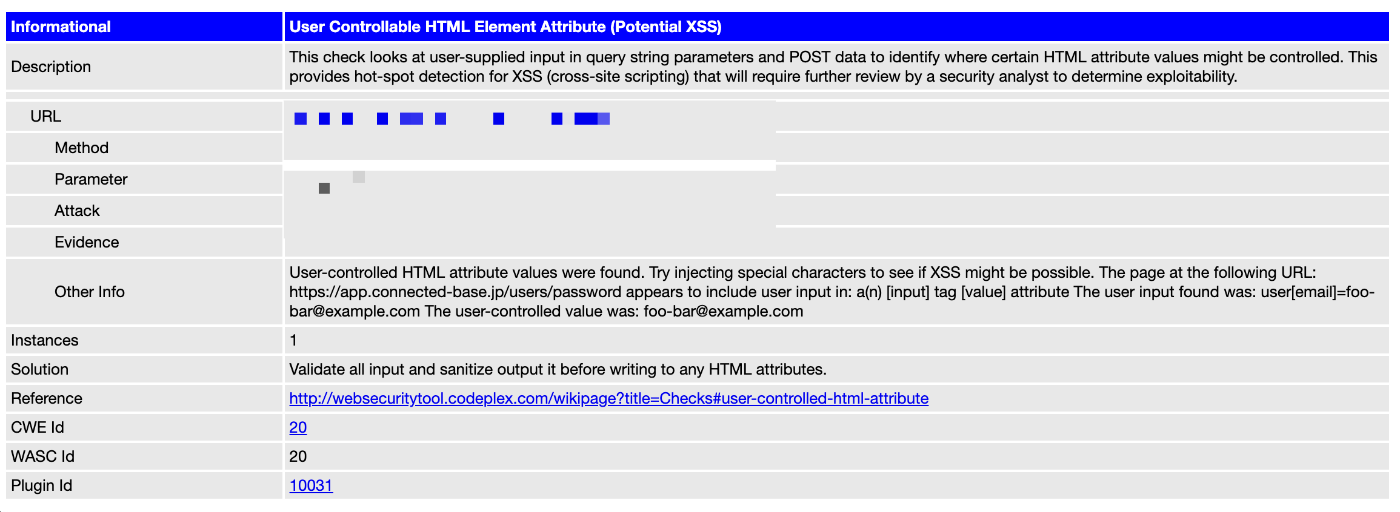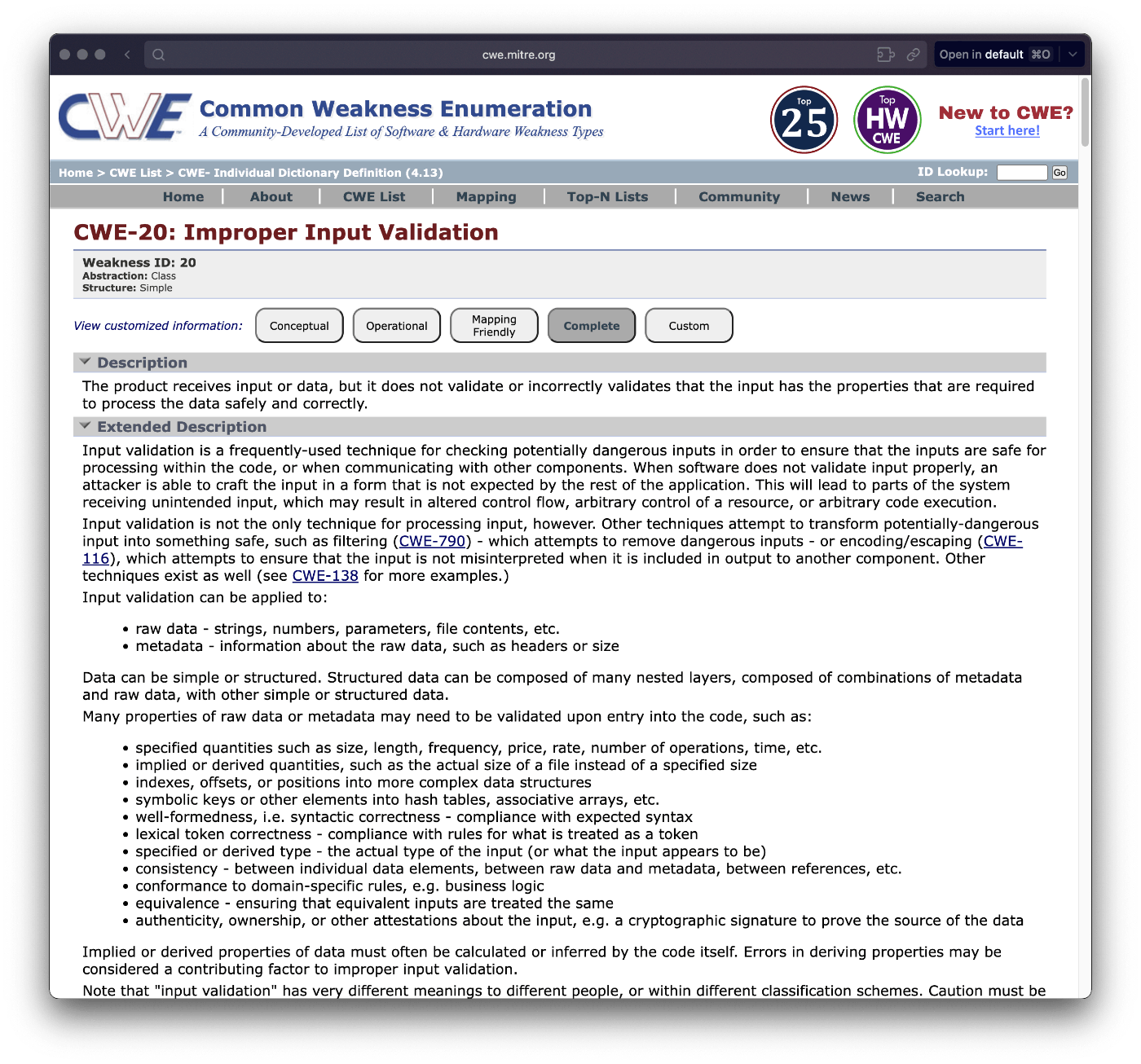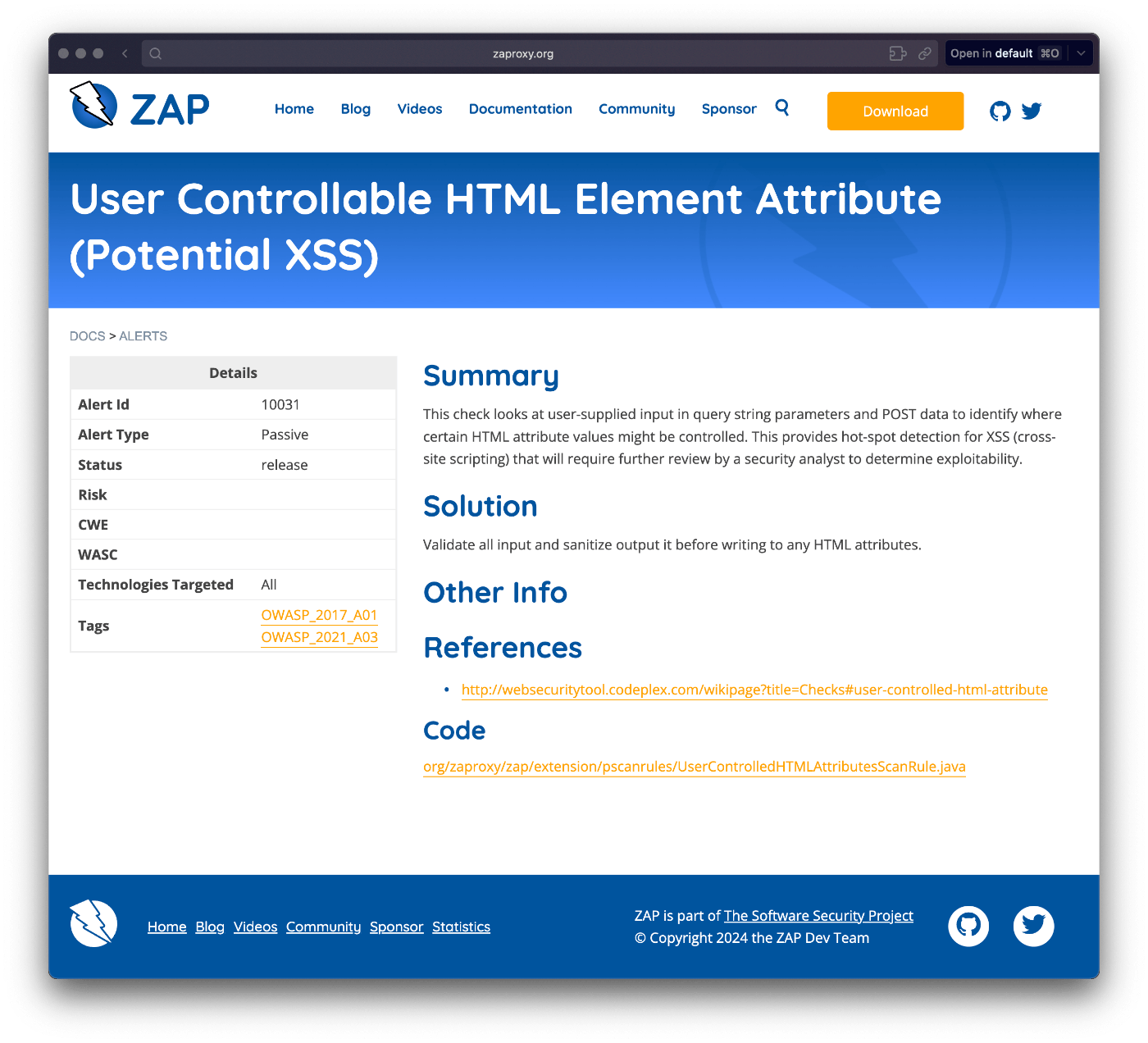Closed16
Docker ベースで Zed Attack Proxy (ZAP) を 使ってみる
Java の環境を用意するのが面倒なので Docker で済ませたい。
Baseline Scan
コンテナで zap-baseline.py を実行する。
docker run \
-v $(pwd):/zap/wrk/:rw \
-t ghcr.io/zaproxy/zaproxy:stable \
zap-baseline.py \
-t https://(対象のドメイン名) \
-z "-configfile option.prop"
zap-basline.py のソースコードは以下
BASIC 認証の対応
対象のサーバに BASIC認証をかけている場合は以下のようにファイルを用意する
用意したファイルを option.prop などの名前で保存しておく
ZAP ログの出力場所
Home は /home/zap
ログは /home/zap/.ZAP/zap.log に出力されている。

以下のコマンドでもログは参照できる
docker cp (container):/home/zap/.ZAP/zap.log - | less
前述のスクショの例だと以下のようになる
docker cp laughing_noether:/home/zap/.ZAP/zap.log - | less
Full Scan
コンテナで zap-full-scan.py を実行する。
docker run \
-v $(pwd):/zap/wrk/:rw \
-t ghcr.io/zaproxy/zaproxy:stable \
zap-full-scan.py \
-t https://(対象のドメイン) \
-z "-configfile option.prop"
zap-full-scan.py のソースコードは以下
結果を XML と HTML で出力する
- HTML
-r results-full.html
- XML
-x results-full.xml
例)
docker run \
-v $(pwd):/zap/wrk/:rw \
-t ghcr.io/zaproxy/zaproxy:stable \
zap-full-scan.py \
-t https://(対象のドメイン) \
-z "-configfile option.prop" \
-x results-full.xml \
-r results-full.html
その他のオプション
$ docker run -v $(pwd):/zap/wrk/:rw -t owasp/zap2docker-stable zap-full-scan.py -h
Usage: zap-full-scan.py -t <target> [options]
-t target target URL including the protocol, e.g. https://www.example.com
Options:
-h print this help message
-c config_file config file to use to INFO, IGNORE or FAIL warnings
-u config_url URL of config file to use to INFO, IGNORE or FAIL warnings
-g gen_file generate default config file(all rules set to WARN)
-m mins the number of minutes to spider for (defaults to no limit)
-r report_html file to write the full ZAP HTML report
-w report_md file to write the full ZAP Wiki(Markdown) report
-x report_xml file to write the full ZAP XML report
-J report_json file to write the full ZAP JSON document
-a include the alpha active and passive scan rules as well
-d show debug messages
-P specify listen port
-D delay in seconds to wait for passive scanning
-i default rules not in the config file to INFO
-I do not return failure on warning
-j use the Ajax spider in addition to the traditional one
-l level minimum level to show: PASS, IGNORE, INFO, WARN or FAIL, use with -s to hide example URLs
-n context_file context file which will be loaded prior to scanning the target
-p progress_file progress file which specifies issues that are being addressed
-s short output format - dont show PASSes or example URLs
-T max time in minutes to wait for ZAP to start and the passive scan to run
-U user username to use for authenticated scans - must be defined in the given context file
-z zap_options ZAP command line options e.g. -z "-config aaa=bbb -config ccc=ddd"
--hook path to python file that define your custom hooks
レポートで指摘された内容について調べる
レポートは以下のような感じで指摘が上がってくる

Evidence にはその指摘の根拠となる値 ( その指摘内容に応じたヘッダーやHTTPステータスなど ) がセットされている。
localhost:3000 をターゲットとして実行する
そのままだと、コンテナ内からホスト側の localhost:3000 は見れないので、 --network host オプションを利用する。
docker run \
-v $(pwd):/zap/wrk/:rw \
--network host \
-t ghcr.io/zaproxy/zaproxy:stable \
zap-full-scan.py \
-t http://localhost:3000 \
-x results-full.xml \
-r results-full.html
config file を利用する
-c config_file オプションで、 Rule に対してて WARN, IGNORE, FAIL のように動作を指定できるらしい。
元となる file は -g オプションで作成できる。
例えばconfigのファイル名が rules.txt だったとして、以下のように実行する。
docker run \
-v $(pwd):/zap/wrk/:rw \
--network host \
-t ghcr.io/zaproxy/zaproxy:stable \
zap-full-scan.py \
-t http://localhost:3000 \
-x results-full.xml \
-r results-full.html \
-c rules.txt
このスクラップは2024/01/04にクローズされました

